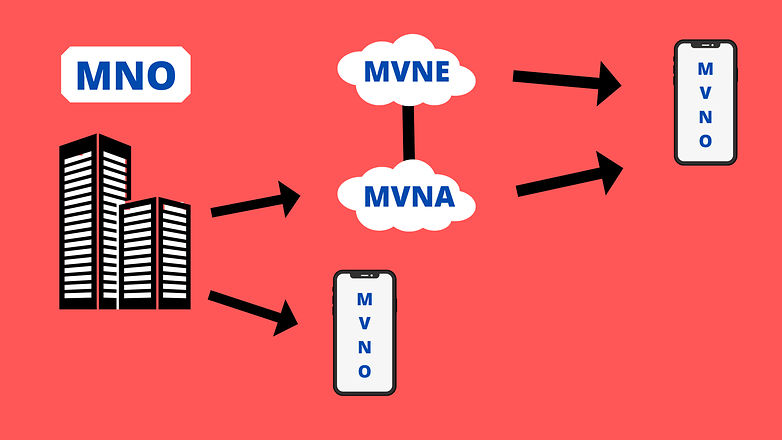Mobile plans: Traditional operator or MVNO, which do I choose in 2022?


Read in other languages:
You want to sign up for a brand new mobile plan but you hesitate between the offer from a classic operator and that of an MVNO? NextPit has thought long and hard about this matter on your behalf and come up with this complete comparison so that you can dive deep into what an MVNO is, the difference between an MVNO and a classic operator, the primary MVNO players, and the pros and cons of an MVNO.
Jump to:
- MVNO: What is it?
- Operator vs MVNO: What's the difference?
- The main MVNO players
- Pros and cons of MVNOs
MVNO: What is it?
What is an MVNO?
MVNO stands for Mobile Virtual Network Operator. An MVNO is a telephone operator that does not own a mobile network or its very own infrastructure. It is therefore an operator who has agreed to use the existing infrastructure of a traditional mobile operator such as AT&T, Verizon, T-Mobile, and US Cellular (who happen to be the MNO or Mobile Network Operator) to operate its network.
For the record, MVNOs first began to operate in the US in 2011. The United States sports four major carriers, and all of them are the backbone for the 139 MVNOs, serving up to 36 million active subscribers as of April 2019 based on a GSMA report. in fact, major States in the USA have also collaborated with a few MVNOs in order to deliver highly accessible mobile and broadband services due to the highly subsidized rate.
MVNOs proved to be very attractive because they offer particularly competitive rates. Over in Europe, Virgin Mobile actually made waves in 2007 by offering an initial SMS offer for just €1. MVNOs are not just a local phenomenon, but a worldwide one. There is a digital transformation happening Stateside, where it is within expectations that MVNOs would target IoT and machine-to-machine (M2M) and connectivity. These providers will then be able to further push the boundaries of out-of-the-box connectivity that are bundled alongside devices and other services within the connected world.
This degree of connectivity is not limited to vehicles, medical devices, wearables, and industrial equipment, and there does not look as though there is any stopping it. MVNOs happen to be well positioned to cater to this industry due to their interesting business model, and the future looks bright for MVNOs.
How does an MVNO work?
On the one hand, there are the traditional operators, the MNOs such as Verizon, T-Mobile, AT&T, and US Cellular. MVNOs piggyback on the network of these MNOs. This relationship can be direct but also through intermediaries, the MVNE and MVNA.
MVNE or Mobile Virtual Network Enablers, are companies that help MVNOs in their network operation. They facilitate relations with MNOs, provide administrative, logistical and sometimes even accounting support.
MVNAs, or Mobile Virtual Network Aggregators, are intermediaries who buy network consumption units in bulk from MNOs and then resell them to MVNOs.
Regarding network quality, MVNOs are expected to offer the same quality as the operator whose infrastructure they are using. However, the reality is that speeds sometimes differ, although there is no evidence that this is a deliberate limitation by the MVNO.

Customers generally choose an MVNO because of its lower prices than those of traditional operators. This kind of lower pricing is made possible mainly due to the fact that MVNOs do not spend money to maintain the network and also due to their subscription mode and the degree of customer service offered.
Indeed, unlike traditional operators, MVNOs do not have stores or at least physical locations where customers can go. Therefore, the only way to subscribe to their offers is through their website. After signing up for a subscription, you will receive a SIM card in due time of which you can insert into your smartphone and start reaping the chosen package's benefits.
As with traditional operators, you will also have the possibility to pick up a smartphone with your subscription, but the prices are also generally higher than with traditional operators.
When it comes to customer service, you normally have to go through the website or communicate by email. Some MVNOs have the advantage of offering a telephone customer service, but that is few and far in between.
The different types of MVNO
There are several categories of MVNO. For this article, we have listed for you, the main types of MVNO with examples for each of them. We find on the market, MVNO general public and those who target professionals.
- Low-cost MVNO or consumer MVNO: While an MVNO is by definition supposed to be already more affordable than a traditional operator, low-cost MVNOs go even further and offer very low prices thanks to their control of operating costs. Example: Boom! Mobile.
- Ethnic MVNOs: These MVNOs, with a rather strange name, is an old category that offers packages or prepaid SIM cards to their customers depending on their nationality or residence. Basically, the idea is to target expatriates, tourists, or migrant workers by offering very attractive prices for calls abroad. Example: Lycamobile.
- MVNOs for professionals: These MVNOs offer mobile plans that are dedicated to companies and sometimes provide specific services to companies. Example: DataXoom.
- Brand licenses: These MVNOs target a well-defined clientele by relying on a well-known brand. Example: Google Fi.
- The "full" MVNO: This type of MVNO has all the features of a classic mobile operator (voice mail platform, mobile switching center and interactive voice server) except for the network coverage. Example: Boost Mobile.
Classic operator vs MVNO: what is the difference?
In the US, there are four major telephone operators: AT&T, T-Mobile, US Cellular, and Verizon. AT&T is the leading operator in terms of number of subscribers and T-Mobile is the leader in terms of 5G coverage across the vast country.
The so-called "classic" operators are those who handle all stages of the provision of their services. In addition to providing network access, they also handle marketing, sales, billing and customer support.
What really distinguishes traditional operators from MVNOs is that they have their own infrastructure with network antennas, cabling, and all the required equipment. As mentioned above, it is the lack of maintenance and development costs for these infrastructures that allows MVNOs to be so competitive on their rates. They do not have the same kind of expenses as traditional operators.
Apart from the fact that MVNOs do not have their own network and therefore use those of traditional operators, there are other subtle differences to look out for between these two types of operators.
The offers from most MVNOs tend to have very little or no commitment at all, and just a few of them offer additional services with their packages, whereas traditional operators offer free or paid options such as Multi-SIM or an International Pass.
However, MVNO offers are not synonymous with poor network quality, as MVNOs are supposed to offer the same coverage quality as the traditional operator whose network they piggyback on. This is ensured by the fact that the operators providing the network to MVNOs have a legal obligation to provide the same network performance to the MVNO's customers as they do to their own customers. Compliance with these obligations is monitored by the authorities.
So, whether you take your package with Good2Go Mobile or FreeUP Mobile on the AT&T network or with Google Fi on the T-Mobile or US Cellular network for example, you will benefit from the same network quality and same speed in principle.
The main MVNOs available in US
There are over a hundred MVNOs available to the masses in the US. To go through all of them is not recommended, which is why we have decided to whittle down the very best from the respective MNOs in the table below.
| MVNO | Network | Range of packages |
|---|---|---|
| Cricket | AT&T | |
| Mint Mobile | T-Mobile | |
| Google Fi | US Cellular | |
| Tello | Sprint |
To find the complete list of all MVNOs operating in the US, you may check it out here.
Pros and cons of MVNOs
In order to better guide your choice, it is important to know the advantages and disadvantages of MVNOs. Do the savings you make on the subscription price require sacrifices that you are willing to make?
The pros of choosing an MVNO over a traditional operator
The main advantage of MVNOs is that they offer more competitive prices. Their offers are also more flexible compared to those from traditional operators. By choosing an MVNO, you will not have to worry about cancellation fees, as most of the packages do not come with a contract. In addition, signing up is a fast and simple process.
The fast activation of your package is also an advantage. Whether it's a question of subscription or customer service, everything goes through the MVNO's website. You will keep the freedom to change your offer at your convenience so that you always have the package that has your best interests all the time.
The MVNO offer is highly customizable to meet other requirements, whether you require a package with very little data just to be able to make calls, or whether you consume a whole lot of data. For instance, you will be able to benefit from targeted packages that favor international communications.
Moreover, these offers are renewed very frequently and there are often interesting promotions on the prices of the packages.
The disadvantages of choosing an MVNO over a traditional operator
The promotional offers of MVNOs are too limited in time and force consumers to keep up to date in order not to miss anything. Doing so can be a time-consuming exercise. Also, customer service can sometimes leave a sour taste in the mouth and is something to be desired, which leads some of their customers to be dissatisfied and voice their concerns on social media.
MVNOs are also suspected of throttling data as you most probably have heard of such things by now. Even if legally this is not supposed to happen, there are many customer feedbacks that complain about it. Given that MVNOs purchase the amount of calls in bulk to provide their customers with such service, it would seem logical if they were to pay by the amount of calls provided. If MVNOs are paying for the amount of traffic they provide to their customers, it would seem logical that they would be tempted to throttle speeds, especially in high-traffic areas such as large cities.
It is impossible to choose the network that the MVNO will operate on. Of course, there are MVNOs with exclusive contracts, but some operate across several different networks. With these MVNOs, the allocation of the network is performed randomly. It can be frustrating to be on the AT&T network when you want to be on the US Cellular network and vice versa.
On the other hand, just a few MVNOs offer 5G at the moment. It is only available as an option for a fee such as Pulse Cellular or is reserved for the most expensive plan.
That's it for now in this comparison of MVNO and traditional operators. Now, the choice is yours to select what suits you best according to your needs. Are you currently with an operator or an MVNO? Why or why not? Would you be willing to change your plan and sign up with an MVNO?




















ja